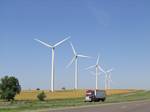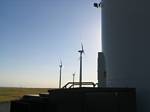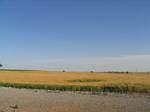Roger J. Wendell
Defending 3.8 Billion Years of Organic EvolutionSM


 NREL (photo by Roger J. Wendell) Wind Technology Center |
Wind Energy and Appropriate Technology (Renewables and other good ideas!) |
"Wind can already be harvested profitably along the coasts and in many other areas throughout the country. It is estimated that only 0.16 percent of the U.S. land mass would be required to generate 300 gigawatts of continuous wind energy - enough to meet the entire electricity demand of the United States. These wind farms could be installed on farm and grazing lands, far away from population centers. Coupled with energy efficiency measures and photovoltaic arrays on most south-facing roofs, this energy mix could provide enough energy to meet our demands."
- Ulf Bossel, The Myth of A Hydrogen Future,
Home Power Magazine 114, August & September 2006, p. 83

|
Click Here for my solar energy page... |

|
Click Here for my page on energy in general... |
"The Department of Energy came out with a study in April of '07 that said we could generate 20 percent of our electricity from wind. And the wind power is -- you know, it's clean, it's renewable. It's -- you know, it's everything you want. And it's a stable supply of energy.""It will be located in [the] central part of the United States, which will be the best from a safety standpoint to be located. You have a wind corridor that goes from Pampa, Texas, to the Canadian border. And it has -- the wind, it's unbelievable that we have not done more with wind. Look at Germany and Spain. They have developed their wind way beyond what we have, and they don't have as much wind as we do."
"But look at Sweetwater, Texas. That town was 12,000 people, then went down below 10,000. The wind came in, it's above 12,000 in population now. The local economy is booming."
"That can be repeated over and over and over again all the way to the Canadian border. Then you have a solar corridor that goes from Sweetwater, Texas, west to the West coast, and that solar corridor can also be developed."
"But we are going to have to do something different in America. You can't keep paying out $600 billion a year for oil."

Why the Wind is So Good for Power
 WindSource Thank You! |
"The power in the wind rises as the cube root of the velocity (wind speed). Because of this wonderful relationshsip, the difference between a 5 MPH breeze and a 15 MPH blowing wind is as follows:"
5 X 5 X 5 = 125
"Or, 1000/125 = 8 times more power at 15 MPH, than at 5 MPH. This cubic relationship means that the power is increasing with wind speed at a really impressive rate! Every electron from the wind can be stored by the battery (or used by the repeater), and even gusts can be 'capture' and put to work." |
Understanding Wind Speed
- Ian Woofenden
Home Power magazine # 143,
June & July 2011, p. 107

Oklahoma
I travel, a lot, and over the years have discovered wind generators in all kinds of places around the globe. These shots are from a frequent route I take along Interstate 40 in Oklahoma. This is the 100+ megawatt Weatherford Wind Energy Center located near Weatherford and Clinton, Oklahoma. These particular towers are HUGE and I can't help pulling over, each time I drive by, to take a long hard look. Of course, I want to discourage others from doing this and especially wouldn't want anyone trespassing to get close-ups either!!!Anyway, this particular wind farm is run by Public Service Company of Oklahoma and featured about 70 generators when I took these photos - each capable of about 1.5 megawatts. Apparently an expansion was underway, at the time I took these photos (Spring 2006) but I couldn't see any evidence of it. Nevertheless, 100 megawatts is still a lot of clean energy that can power over 75,000 typical American households!!
 1. IEA Wind 2009 Annual Report |
 2. |
 3. |
 4. |
 5. |
 6. |
 7. |
 8. |
 9. |
 10. |

What is Appropriate Technology anyway??
- The 1993 edition of The Dictionary of Ecology and Environmental Science defines Appropriate Technology as as an "Applied science that is suitable for the level of economic development of a particular group of people. Approrpriate technology is decentralized, can be understood and operated by by its users (i.e., does not require outside operators), uses fuel and other resources that are either local or easily obtrained, and involves machinery that can be maintained and repaired by its users. Often, but no necessarily, it is labor-intensive and involves simple machinery."
- I believe Appropriate Technology is being mindful of what we're doing and being aware of the consequences. An example might be the use of a 4,000 pound vehicle for a trip to the conveince store - Couldn't you make the trip on a bicycle and do you really need that 1/2 pound of icecream anyway?!
- Steve Troy, * of the Sustainable Village, says it this way;
"The definition of 'Appropriate Technology' changes with each situation. It's not appropriate to install solar modules in a place with very little sun, a wind generator in a place with little or no wind. What's appropriate in a large urban location is very different from what's appropriate in a remote, isolated environment. One quality that remains the same, however, is taking care of things. In each situation, the essence of AT remains appreciating, helping, caring. Planned obsolescence, throw-away products, poor quality all go against intelligent decision-making and the true spirit of appropriate technology."
- My own feeling is that Appropriate Technology is a much more "common-sense" philosophy than its fancy name implies. Although our grandparents, and those before them, didn't have the same lexicon (or "High" Technology!) they knew what was appropriate and what wasn't. It's not too late - we, too, can adopt their same "Can do" spirit of frugality** and efficiency!
*I received permission from Steve, himself, to quote him here
**I've also been doing some work on "Frugality" at www.VoluntarySimplicity.info

Birds and Wind Turbines
NREL
China's Silk RoadAlthough I think wind is an important energy source I do have a concern about bird collisions with turbines. However, it may be interesting to note (unfortunately) that birds collide with all kinds of buildings and structures regardless their function. Anyway, I'm pretty lucky in that I live near the National Renewable Energy Laboratory's (NREL) Wind Technology Center. I hope to stop by more often and grab a few more photos for this page. In addition to the NREL photos, at far left, I also ran across a field of wind turbines while traveling near the ancient Silk Road in northwest China.
Did You Know?

3.7 Pounds of fossil fuel and chemicals are needed to create a single 2-gram microchip.
Source: Environmental Science & Technology, a journal of the American Chemical Society.

|
My computer, reading light, and everything else at home (where I create these web pages) is 100 Percent wind powered! - Roger J. Wendell |

Links:
|
|

 Back to Roger J. Wendell's Home Page...
Back to Roger J. Wendell's Home Page...
Abbey |
About |
Blog |
Contacting
Me |
Copyright |
Disclaimer |
Donate |
Guest
Book |
Home |
Links |
Site
Index |
Solutions |
Terms,
Conditions
and
Fair
Use |
What's
Changed
or
New?
Copyright
© 1955 -